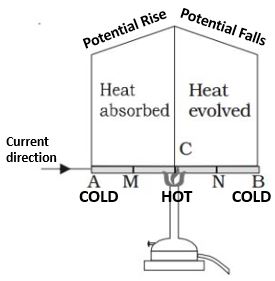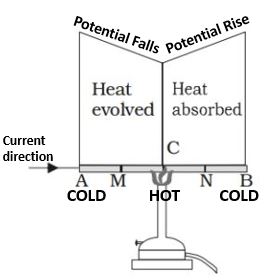The absorption or evolution of heat energy, if a current is allowed to flow in a conductor having its different parts of different temperatures is known as Thomson effect.
or
When a current flows through an unequally heated conductor, there is an absorption or evolution of heat in the body of the conductor. This is known as Thomson effect.
In Thomson effect, we deal with only metallic rod and not with a thermocouple as in Peltier effect and Seebeck effect. That’s why sometimes it is known as a homogeneous thermoelectric effect.
The evolution and absorption of heat energy at junctions of a thermocouple, when a current is passed through it, is called as Peltier effect.
Types of Thomson effect
Positive Thomson effect
In positive Thomson effect, it is found that hot end is at high potential and the cold end is at a low potential. Heat is evolved when current is passed from hotter end to the colder end and heat is absorbed when current is passed from colder end to hotter end. The metals which show positive Thomson’s effect are Cu, Sn, Ag, Cd, Zn, etc.

Consider a copper bar AB heated in the middle at the point C and current flowing in the direction from point A to the point B in figure 1. When no current is flowing, the point M and N are equidistant from point C and hence at the same temperature. When a current is passed from A to B, point N shows higher temperature compared to M. Similarly, point B will show higher temperature as compared to point A. It means from point A to point C, heat is absorbed and from point C to point B heat is evolved. This is known as positive Thomson effect.
Negative Thomson effect
In negative Thomson effect, it is found that the hot end is at a low potential and the cold end is at a higher potential. Heat is evolved when current is passed from colder end to the hotter end and heat is absorbed when current flows from hotter end to colder end. The metals which show negative Thomson’s effect are Fe, Co, Bi, Pt, Hg, etc.

Consider an Iron bar AB heated in the middle at the point C and current flowing in the direction from point A to the point B in figure 2. When no current is flowing, the point M and N are equidistant from point C and hence at the same temperature. When a current is passed from A to B, point N shows lower temperature compared to M. Similarly, point B will show lower temperature as compared to point A. It means from point A to point C, heat is evolved and from point C to point B heat is absorbed. This is known as negative Thomson effect.
Thomson coefficient (σ)
The amount of heat energy absorbed or evolved when one-ampere current flows for one second (one coulomb) in a metal between two points which differ in temperature by 1ºC is called Thomson coefficient. It is denoted by σ. Its unit is volt per ºC.
